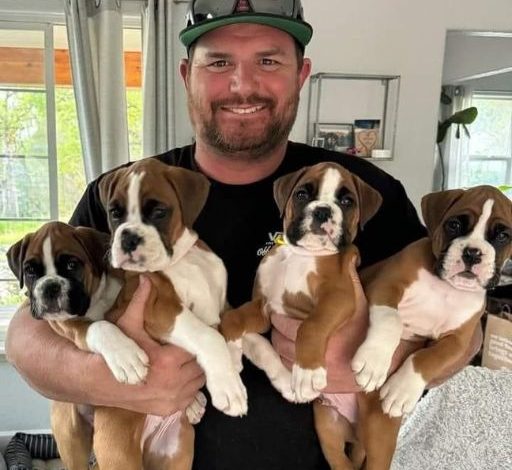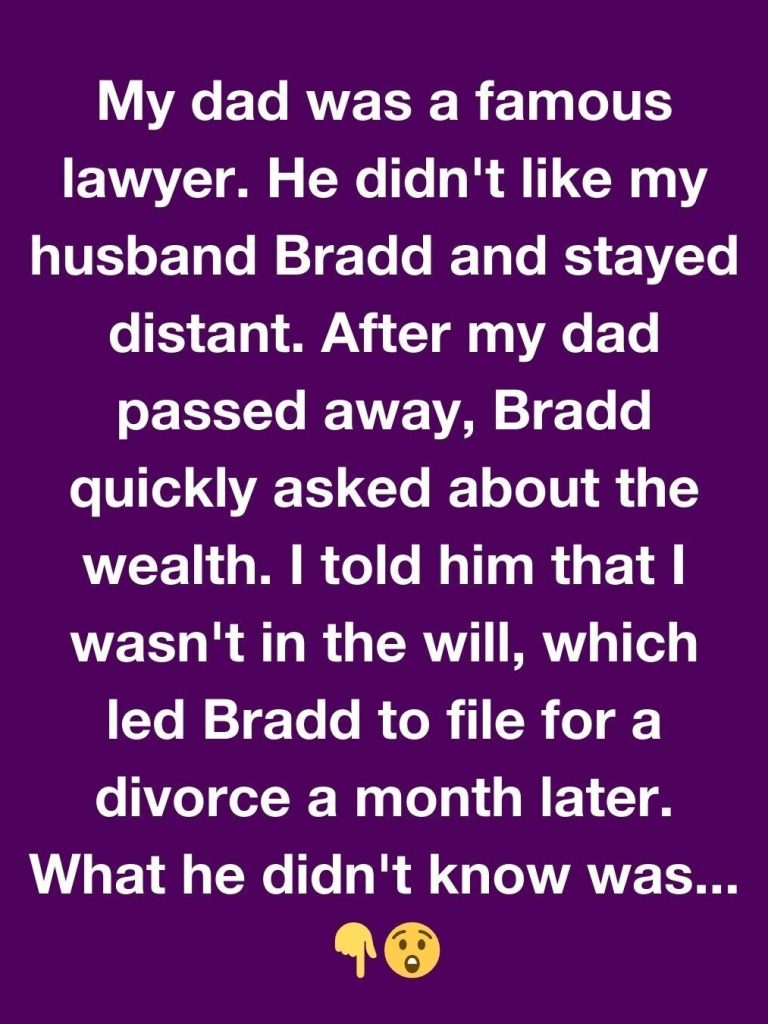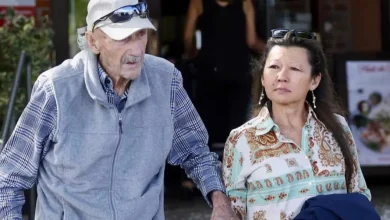
On the side of the road, I discovered four boxer puppies, and one of them had a collar that completely changed the situation
I was driving along County Road 12 on a hectic morning when I noticed something unexpected by the side of the road—a small group of four boxer puppies, muddied and shivering like fragile leaves in the wind, huddled near a ditch. I had no plans to stop; I was already behind schedule for an important customer meeting and had endured a trying morning. Yet, when I saw them, I couldn’t just drive past. There was no sign of a mother dog or any nearby dwelling—only the puppies and a battered, half-collapsed box lying in the grass. Without a second thought, I pulled over.
I scooped up the trembling puppies using an old hoodie I had in the car and quickly made a call. I decided to bring them home immediately. After a brief bath in the laundry sink and drying them off on a stack of towels, I planned to scan them for microchips and post their pictures on a local lost pets group. It was then that I noticed one of the puppies sported a yellow collar. Despite its dirt-stained appearance, the collar held a small, handwritten tag tucked under the clasp. The tag, with only the words “Not Yours” scrawled on it, sent an involuntary shiver down my spine.
Later, when my friend Tate—a veterinary technician—saw the tag, his expression turned grave and he fell into a long, thoughtful silence. He mentioned that he’d seen something similar before, though he wouldn’t divulge the location. After a long pause, he warned me, “These pups might not be as lost as you think.” His tone urged caution about discussing it further, and even though I couldn’t quite grasp his meaning, I sensed that there was a darker undercurrent to this discovery.
The phrase “Not Yours” kept echoing in my mind as I locked my doors the following morning. I couldn’t help but wonder who might have written those words and why. Later that day, Tate returned with a scanner to check the microchips in the puppies. The one with the yellow collar beeped immediately, while the other three had no chips at all. Using the chip information, we traced the puppy’s registration to a veterinary facility several counties away—a place that, according to a surprised receptionist, hadn’t registered that dog in years. She even added that they no longer held its owner information. The numbers didn’t add up: these puppies were no older than eight weeks.
Tate’s silence deepened my suspicions. He eventually confided, “There are people out there who breed dogs for reasons you really don’t want to know about. That collar might be a warning sign.” When I pressed him further, he murmured, “It could be connected to rings involved in fighting—or worse.” The thought of illegal activities, like dogfighting, lurking beneath the surface in our rural area made my heart constrict. I realized that these vulnerable puppies needed protection, not exposure on social media.
I decided to keep the puppies hidden at my house for the next four days. Every unexpected knock on my door sent me into a panic, even though the puppies themselves were sweet and clumsy. I convinced myself that it was unlikely anyone would come searching for them. Yet one late night, I heard tires crunching on my gravel driveway. Peering through the slats of the door, I saw a weathered truck parked outside. Two men, wearing baseball caps and thick boots, emerged—one clutching a leash and the other carrying a flashlight. Panic shot through me like lightning. I immediately locked myself in the bathroom with the puppies, turned off all the lights, and grabbed my phone. Though I couldn’t reach Tate instantly, I managed to text my neighbor Jessa, urging her to call the sheriff if she noticed anything unusual.
Time blurred as I listened to muffled voices outside and one loud knock on my door. The intruders tried the doorknob, and I could hear hushed voices—one apologetic, the other laced with low anger. I caught snippets: “They’re not here,” one said, “They were probably found by a child and taken to the pound.” The other declared, “Damn it. We will find them if they are still alive.” The phrase “still alive” made my heart sink, and I wondered what they really meant. After a nerve-wracking period, the men eventually drove off, tires crunching as they sped away. I waited an extra hour before cautiously emerging from my hiding spot, and Jessa later texted me that the sheriff was on his way.
Deputy Ruiz arrived and listened carefully to my account, though he seemed skeptical. “Are you sure it was those same guys?” he asked. I replied firmly, “I’m positive—they weren’t here to adopt; they were looking for something else.” Although Ruiz agreed to keep an eye out, I sensed he thought I was overreacting. Later, I broke Tate’s advice and posted photos of the puppies online, deliberately omitting any mention of the yellow collar. Within hours, generous adoption offers poured in from sympathetic strangers, but one comment from a user named @DogMom92 stood out. She posted a picture of a mature boxer wearing the same distinctive yellow collar, captioning it, “This is Max.” She explained that Max had disappeared from her property during a thunderstorm six months ago, and after exhaustive searching, she concluded he had either been taken or hit by a car. Although she was unaware of any direct ties to illegal activities, she mentioned that Max had been subjected to multiple breedings before his adoption.
I immediately messaged her, and as more details emerged about Max’s story, everything began to click into place—breeding, fighting, disappearing dogs. With @DogMom92’s consent, I relayed her information to Deputy Ruiz. At first, he brushed it off, but as I clarified the connection between the yellow collar and the timeline, his tone shifted. “Let me investigate this,” he said. “We need to break any pattern that might be forming.”
A week later, Deputy Ruiz returned with news. His team had located a secluded residence hidden in the woods after several neighbors reported unusual nighttime truck activity. The following day, animal control organized a raid. I’ll never forget the horrors I witnessed: dozens of dogs crammed into dirty cages, many undernourished or injured. Max was among them—wounded yet clinging to life. Two men were taken into custody on suspicions of illegal breeding and animal abuse, with evidence suggesting they had been supplying dogs for illegal fighting rings.
When @DogMom92 was finally reunited with Max, tears flowed freely from both her and me as I realized just how much these puppies had suffered. She took in all of them until they were old enough for adoption, declaring, “Max deserves his family back,” and promising to provide a safe, loving home for every one of them.
In the end, what started as a chance roadside discovery turned into a mission to rescue lives. Saving those four boxer puppies was not only about giving them a safe haven but also about exposing a darker underbelly of dog breeding and fighting rings that prey on vulnerable animals. This experience reinforced for me that sometimes taking a risk is necessary to do what’s right. If you ever find yourself hesitating to help those in need, remember—you have the power to change the world for them and for yourself.
If this story inspired you, share it with your friends. You might just spark a chain reaction of compassion and courage.




